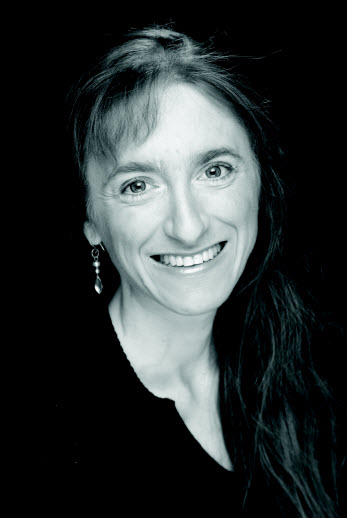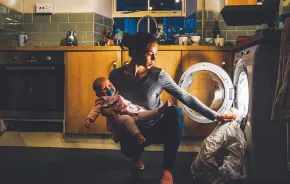 Shana Bestock is artistic director and education director at the Seattle Public Theater (SPT). Since 2000, when SPT became the resident theater company at the Bathhouse, it has become one of Seattle's premiere mid-sized theaters, known for its robust education program as well as top-notch professional productions.
Shana Bestock is artistic director and education director at the Seattle Public Theater (SPT). Since 2000, when SPT became the resident theater company at the Bathhouse, it has become one of Seattle's premiere mid-sized theaters, known for its robust education program as well as top-notch professional productions.
When did you begin your involvement with theater?
I was in my first Shakespeare class at 8 years old. I was fortunate to grow up alongside the Seattle Children’s Theatre (SCT); I spent all my formative years there and had great acting teachers. My parents saw it was something I loved and thrived on. As a child, I preformed professionally in productions that included The Best Christmas Pageant Ever, Our Town at the Seattle Rep — where I worked with Dan Sullivan, and The Secret Garden at SCT.
Have your childhood experiences in theater informed your mission and goals?
Yes — I realized I wanted to create opportunities for people who are not necessarily actors. I attended the University of Chicago, where I worked in southeast Chicago — an impoverished area — in theater programs for elementary and middle school kids. And I decided I wanted to establish a theater in Seattle with vibrancy — a place where the mainstage and the youth education program are equal.
At SPT, the mainstage and the youth programs share the same space and everyone has ownership of that space. The kids get on the stage, run the booth and are a part a professional theater.
How does SPT’s education program differ from other kids’ theater programs?
Kids come to us for a different sort of experience. We are smaller, more of a community, we are not audition-based, and there’s a lot of one- on-one interaction with the students. For example, I’m having a party at my house for teens in the program. They’ll read plays and we’ll talk about what plays we want to do next year. We base the programs on the kids’ needs.
We also let the kids have a voice in what parts they want and why. We put on great shows — but what we’re about is creating theater. It really becomes a culture and a community.
How does drama and on-stage experience help kids grow and develop?
It gives kids a safe place to be passionate and a safe place for expression. It’s a place where they can try on new hats. And they can be themselves in the process of becoming themselves, which is a terrifying thing to do.
It’s important to offer kids another language they can use to express themselves. Theater does that. It offers a space, a literal home away from home, away from school, a “third place.” They can hang out and not be with their parents, but be with their peers. It helps them create their identity. It offers them a chance to tell stories.
We just did a project called the Hunger Plays. Girls wrote plays about bullying and, as part of the process, they wrote letters to their younger selves. Some said, “Don’t lose your capacity for wonder, for play.” There’s pressure when kids are growing up to lose their sense of wonder, of delight, and of risk-taking. Theater offers kids the chance to take huge risks.
There are very basic skills students learn in theater, also: To listen, work together, deal with disappointment. They learn resilience. Maybe they don’t get the role they wanted in one production. But we offer a lot of plays. They learn to bounce back from disappointment — that if they don’t get cast as the lead in one play, there will be another opportunity.
Are you training kids to pursue careers in the theater?
It’s not really about career, though some of the kids will pursue theater in some capacity — whether as professionals, amateurs or as audience members. And we are also educating kids to be theatergoers.
At the same time, we are educating their parents. Parents will go see a show six times. They learn what goes into making theater. What we’re doing is creating an engaged citizenry.
On your website, you quote the poet Wendell Berry: Live a three-dimensional life. Communicate slowly. Avoid screens. How do these words personify SPT’s mission?
I think it’s my job to get kids to turn 360 degrees to see the world, to have a multisensory experience and live that “three-dimensional life.” We are trying to foster authenticity, emotional trust and joyousness. That does not come off a screen.
Kids actually want to be told to turn off their cell phones and put away their iPads. Theater offers language for them. Maybe texting isn’t the language they feel most comfortable in. Some kids are thinking, “Thank God — when I’m in my phone persona, I feel false.” Middle-schoolers, especially, want the structure — they want someone to say, “Here’s the part, the script. Now take a risk.”
Kids want someone to say to them, “Be here with each other, just BE.”
SPT has an amazing outreach program with the public schools and homeschool groups. Why is that important to you?
Many elementary schools don’t have a theater program that fits their needs. We work with parent groups as producing partners. We have a scholarship fund; we commit to making it possible for any child to come study with us. And we offer financial aid that’s need-based.
Are kids able to get an education in the arts in today's schools?
The arts have traditionally been underserved in Seattle Public Schools, and there is currently a serious study underway to discuss this again — representing a lot of money, a lot of discussion, a lot of educator-speak and a lot of bullet points.
Arts education, especially at the elementary school level, has historically relied on two factors — Artists-in-Residence, funded through grant money and/or PTA funds, who do specialized residencies that, if successful, leave classroom teachers empowered with more skills to incorporate the arts in their curriculum. I used to make my living doing these residencies, and loved 'em! These usually rely on their ability to "tie in" to standard curricula to justify their existence.
The second factor is the after-school program, typically run by parents (sometimes a stipended volunteer or extra staff person), where the arts are given an hour a week as a "club" or class experience. These can be engaging and fun, but are plagued by inchoate programming, rapid turnover and little consistency, and a "splash" effect that leaves parents (and kids) with the sense that the arts are a form of daycare.
Arts educators in the schools are responsible for the artistic growth of so many kids it's hard to develop individual artists — plus they have to justify their work with all sorts of benchmarks and evaluations that can make arts feel like homework in a less than creative way.
Yes, kids are able to get an education in the arts. But often it's an education in the same way that kids are taught to add numbers and diagram sentences. It's not an education that gives them real understanding of the whys, the possibilities. The school system focuses a lot on answers, not questions, which are essential to the arts.
Plus, there's the whole issue of disparity, about which I feel quite passionately. I once taught a class in Shoreline in the morning and at Kimball in the afternoon. Same me, same program, totally different populations. I felt like I was single-handedly trying to equalize society. The Shoreline program was funded entirely by parent tuition, the Kimball program entirely by a government grant (since dried up).
I'd like to see a return to focusing on school/arts, organization/artist partnerships. I don't think all schools are capable of supporting fully robust programs in the arts entirely on their own. Some develop a program — Roosevelt Drama or Jazz, for example — that takes off, but still relies on outside fundraising, a measure of public success, marketing, etc. With so many wonderful arts organizations in Seattle and so many wonderful artists seeking a living, there can be more discussion on getting the arts into the schools (and into the school day) in meaningful, sustainable programs that don't ask the schools to shoulder the whole burden.
I could write a whole essay on the drama programs at several high schools, and why kids deeply involved with those programs still choose to come to a place like Seattle Public. Performing Arts is a special beast in the schools, relying as they do on ensemble and working together. The culture of each program (especially at the middle and high school levels, but also at the elementary level) therefore is part of the education. Some programs foster competition, some foster the "we're all pals" vibe — but no one program is good for all kids.
Linda Morgan is the managing editor of ParentMap and the author of Beyond Smart: Boosting Your Child's Social, Emotional, and Academic Potential.









